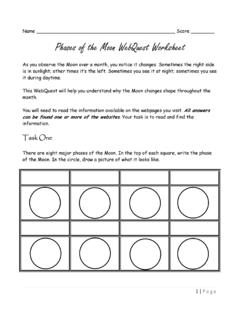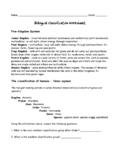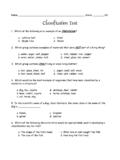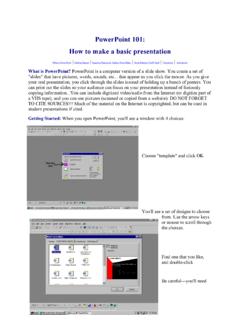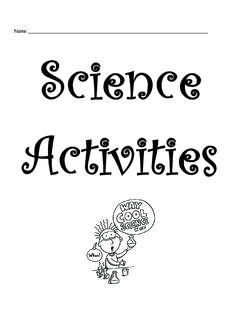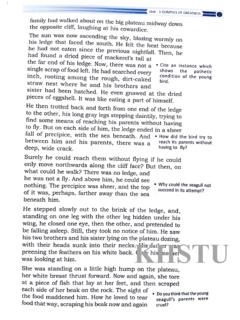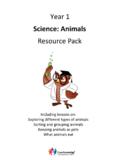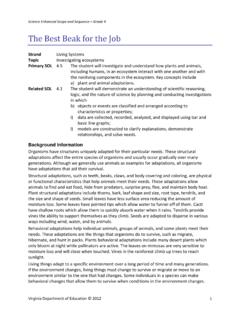Transcription of Bird Beaks - Mr. Hill's Science Website
1 bird Beaks Purpose In this activity, you will get a chance to find out how the shape of a bird s beak helps decide what it can eat. Pretend you are a bird . You can use only the beak you select (spoon, chopstick, or tweezers) to eat the food (glass marbles, pennies, or toothpicks) provided by your teacher by placing the food into your stomach (plastic cup). Materials Spoons Chopsticks Tweezers Plastic cups Glass marbles Pennies Toothpicks Cup Procedure 1. Select a beak from the objects provided by your teacher. 2. Get one plastic cup. This cup represents your stomach. 3. Hold your beak in one hand and your stomach in the other.
2 4. When your teacher tells you, use your beak to pick up food (glass marbles) and place them in your stomach. 5. When your teacher says Stop, empty your stomach and count the number of items that were in it. Record this amount on the bird Beaks Record Sheet. 6. This activity will be repeated for each of the other types of food (pennies and toothpicks). 7. When done, be sure you have completed the record sheet with your totals. 8. When asked, provide your data to other group members who will record the data on a group grid. (A copy of this grid is also on your bird Beaks Record Sheet. You can write the group totals on this grid if desired.)
3 9. Using the data that has been recorded on the group grid, create a bar graph that shows the group totals for each beak and food type. The three different bird Beaks should be on the X-axis and the amount of food collected should be on the Y-axis. There should be a different color bar for each type of food (see the sample bar graph below). Name _____ What Fits Best? Objective Students will choose the proper Beaks and feet and "build" a bird that is compatible with a particular habitat. Work Sheet I The Beaks of birds are adapted to the ways in which birds get their food. The following are descriptions of different kinds of Beaks : 1.
4 Spear Beaks are sharp and long. 2. Predator Beaks are curved, heavy, and powerful. 3. Chisel Beaks are pointed for cutting and boring holes. 4. Scoop Beaks allow a bird to scoop food out of the water. 5. Strainer Beaks enable a bird to hold food while water is strained from it. 6. Cracker Beaks help birds break the hard shells of seeds. Identify the six bird Beaks pictured below. Write your answer on the line underneath each beak: Write your best answer below each of the following questions: 1. Which Beaks are best for spearing and chiseling?
5 Explain. _____ _____ 2. Which beak is best for cracking seeds? Explain. _____ _____ 3. Which beak is best for straining? Explain. _____ _____ 4. Which beak is best adapted for tearing meat? Explain _____ _____ 5. Which beak is best for holding a large amount of food? Explain. _____ _____ 6. How can a bird 's bill or beak tell us about what it eats? _____ _____ Worksheet II The feet of birds are adapted to help birds get their food and to allow them to move around when not in flight. Following are descriptions of different kinds of bird feet: 1. The feet of swimmers are webbed to help them paddle through the water in their search of food.
6 2. The feet of waders help them search for food on the bottom of a marsh or bay while supporting them and giving them balance. Waders also have long legs. 3. The feet of predators are curved and have sharp talons that allow them to catch and carry their food. 4. The feet of climbers have toes facing in both directions. The toes are like sharp claws which help the bird to climb trees in search of food. 5. The feet of perchers enable the bird to grasp a limb or branch. Each foot usually consists of three toes pointing forward and one pointing backward. This "backward toe" is as long as the front middle toe. 6. The feet of ground birds and runners help them move through the undergrowth of the forest.
7 Three toes point forward. The fourth toe is much smaller and points backward. Identify the six bird feet pictured below. Write your answer on the line beneath each pair of feet: Write your answer below each of the following questions: 1. Which feet are best suited for swimming? Explain. _____ _____ 2. Which feet are best adapted for wading? Explain. _____ _____ 3. Why do wading birds have long legs? Explain. _____ _____ 4. Which feet are best for catching and carrying? Explain. _____ _____ 5. Which feet are best adapted to climbing?
8 Explain. _____ _____ 6. Which feet enable a bird to hold onto a branch or limb? Explain. _____ _____ 7. Which feet are best suited to moving on the ground? Explain. _____ _____ 8. How can a bird 's feet tell us about what the bird eats? _____ _____ Build-a- bird The "Build a bird " activity will help you see that different Beaks and feet allow different kinds of birds to live in different places. 1. Select the kind of bird you want to make from the types listed below. 2. Next, cut out the bird body form. Then, cut out the head, beak, feet, and tail that will correctly complete your bird . Once this is done, carefully arrange the bird parts on your sheet of construction paper and glue them in place.
9 Use colored pencils or crayons to decorate your bird . Be sure to label your bird using one of the types named below. Types 1. Marsh or Wading bird -This bird needs a long neck for fishing, long legs for wading, and a narrow, pointed bill for spearing its prey (fish, frogs, snakes). 2. Seed-eating bird -This bird needs a thick, strong bill for cracking seeds, a short neck, and perching feet. 3. Predator (hunting bird )-This bird needs a curved beak for tearing meat, a short, muscular neck, and feet with talons for catching and holding prey. 4. Water or Swimming bird -This bird squeezes water from food it catches.
10 Its wide bill holds the food while allowing water to drain from it. It has broad, webbed feet that act like paddles and make it a good swimmer. 5. Insect-eating bird -This kind of bird has a thin pointed bill, short neck, and broad tail. Some may have climbing feet (woodpecker), while others will have ground or runner s feet (pheasant). 3. Explain why your bird would survive in your chosen habitat. Chose habitat - _____ Explanation _____ _____ _____ _____ _____ _____ _____ _____ _____ Name _____ bird Beaks Evaluate your results and answer the following questions.
